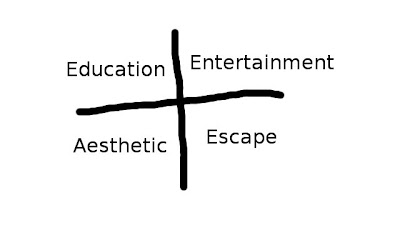The Values of An Experience
People value 4 basic things in an experience: education (what did I learn? how am I different?), entertainment (did it make me laugh? did it feel fun and interesting?), aesthetic (was it comfortable? was it beautiful?), and escape (did I lose track of time? did I feel like I was somewhere else for a little while?).

Problem vs Pain
When an organization brings on a consultant, it's usually because they've identified some problem they want help dealing with. For example, a museum may say that they want to increase visitors coming through the doors on weekends. That's their problem. But it's worth digging in to what their pain is. Maybe their pain is that their revenue is steadily decreasing. Or they put a lot of resources into weekend programming and aren't seeing a return. The pain gets at why the problem is a problem.
Ways to Change the Experience
When an organization is looking at changing the customer experience, they have 3 ways to go about it. First, the physical environment: what people see when they come and how it makes them feel. Think colors, textures, furniture, light. Second, the process: how people find their way, what they can (and can't do). Think signage, walkways, admissions or reference desks. Finally, human: the people they interact with and how they interact with them. Think front desk staff, docents, guides.
The Change Timeline
When organizations recognize they have a new vision, strategy, or direction to pursue, they often want to get there right away. Practically speaking, change takes time. This framework says 3 years. The yellow scribble at the end of 3 years is the organization's vision of where they want to be. It's a scribble because, while it's got some definition, it's still going to be vague - it will shift and grow and become defined in this 3-year process.

At the beginning of the timeline is the Ending. Organizations often start the vision/strategy process by identifying that there are things they want to stop. Things that aren't working right. Next, they move into Neutral. This is where they are trying new things out (hence the squiggly lines - guess and check, trial and error). They expect some failure, they expect some success. Finally they get to the Beginning. They've identified a few things that work. They move forward, full speed ahead.
The check marks at the bottom are check points for the organization. It's easy to get discouraged and to feel like things are never going to take shape. By making a list of milestones in advance, then organizations can point those out as signs that they're on the right track.
No comments:
Post a Comment